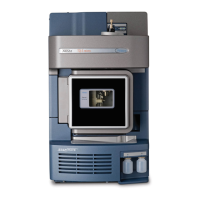viii January 11, 2016, 715004599 Rev. B
Hazards associated with removing an instrument from service
When you remove the instrument from use to repair or dispose of it, you must
decontaminate all of its vacuum areas. These are the areas in which you can expect to
encounter the highest levels of contamination:
• Source interior
• Waste tubing
• Exhaust system
• Rotary pump oil (where applicable)
The need to decontaminate other vacuum areas of the instrument depends on the kinds of
samples the instrument analyzed and their levels of concentration. Do not dispose of the
instrument or return it to Waters for repair until the authority responsible for approving its
removal from the premises specifies the extent of decontamination required and the level
of residual contamination permissible. That authority must also prescribe the method of
decontamination to be used and the appropriate protection for personnel undertaking the
decontamination process.
You must handle items such as syringes, fused silica lines, and borosilicate tips used to
carry sample into the source area in accordance with laboratory procedures for
contaminated vessels and sharps. To avoid contamination by carcinogens, toxic
substances, or biohazards, you must wear chemical-resistant gloves when handling or
disposing of used oil.
Bottle placement prohibition
Warning: To avoid personal contamination with biohazards, toxic
materials, or corrosive materials, wear chemical-resistant gloves
during all phases of instrument decontamination.
Warning: To avoid puncture injuries, handle syringes, fused silica
lines, and borosilicate tips with extreme care.
Prohibited: To avoid injury from electric shock or fire, and to prevent damage to
the workstation and ancillary equipment, do not place objects filled with
liquid—such as solvent bottles—on these items, or expose them to dripping or
splashing liquids.

